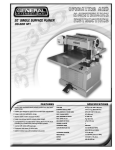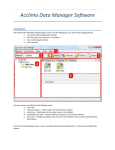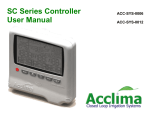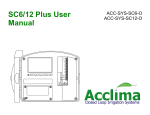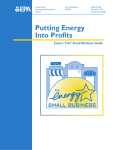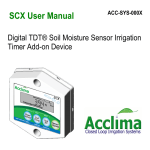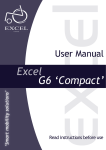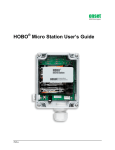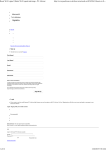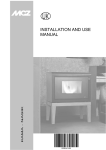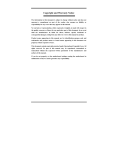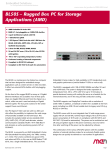Download SC24 and SC36 User Manual
Transcript
HelpAndManual_unregistered_evaluation_copy SC Series Controller User Manual Model SC24, ACC-SYS-0024 Model SC36, ACC-SYS-0036 Table of Contents SC24-36 Controller 1 Introduction ...................................................................................................... 1 Controller Components ...................................................................................................... 1 Controller Installation 2 Mounting the Controller ...................................................................................................... 2 Connecting the Valves ...................................................................................................... 3 Connecting a Master ...................................................................................................... Valve, Flow & Pressure Meter 4 Connecting a Pump ...................................................................................................... 4 Connecting the power ...................................................................................................... source, and ground 5 Connect a Rain Sensor ...................................................................................................... 5 Getting Started 6 Sprinkler System ...................................................................................................... Basics 6 About the Sensor...................................................................................................... Sensor............................................................................................................. Installation Sensor............................................................................................................. Configuration Timer Programs ...................................................................................................... 6 7 8 9 Sensor Programs...................................................................................................... 9 Planning a Water...................................................................................................... Schedule 9 Controller Programming (basic) Auto/Run 10 ...................................................................................................... 10 Set Time & Date...................................................................................................... 10 Off-Add or Remove ...................................................................................................... Hardware 11 Water Schedule...................................................................................................... 12 Watering Start Times ...................................................................................................... 13 Soil Moisture Sensors ...................................................................................................... 13 Zones ...................................................................................................... 14 Controller Programming (advanced) Soak Cycle 15 ...................................................................................................... 15 Flow Management ...................................................................................................... 15 Test ...................................................................................................... 17 Event Pause ...................................................................................................... 18 Advanced Options ...................................................................................................... 19 Water Budget/Rain ...................................................................................................... Delay 21 Glossary 21 My Irrigation Schedule HAVE A QUESTION, PROBLEM, OR COMMENT? Our toll-free Technical Service phone number is 866-887-1470 25 Limited Product Warranty HAVE A QUESTION, PROBLEM, OR COMMENT? Our toll-free Technical Service phone number is 866-887-1470 27 Installation and Operation Manual SC24-36 Controller Introduction Congratulations on your purchase of the Acclima SC24/36, the finest soil moisture sensor irrigation controller on the market. You have joined in conserving water—earth's most important resource. Suspended Cycle™ Irrigation The Acclima SC24/36 is a Suspended Cycle™ irrigation controller that utilizes advanced Acclima Digital TDT™ soil moisture sensors that report accurate soil moisture readings to the controller regardless of soil type, temperature, compaction or soil chemistry. Like conventional controllers the SC24/36 uses watering schedules to determine when a zone will irrigate, but unlike conventional controllers the zone will not water during a given watering cycle if there is already sufficient moisture in the soil. At the beginning of each programmed watering cycle the controller takes a moisture reading from the sensor governing that program. If the moisture is above the 'watering threshold' you have set for that program, the watering cycle will be suspended until the next programmed start time. If the moisture level is below the 'watering threshold' then the full cycle will run as programmed. During wet or cool periods you will notice less watering activity from your Acclima system. During hot, dry periods you will notice more watering activity. The Acclima SC24/36 is an advanced controller allowing you to maximize the efficiency of your sprinkler system. The controller allows for simultaneous multiple zone watering based on your settings. You have the flexibility to set each zone to run on a conventional timer program or on a sensor-controlled program. These options allow for customization of the controller to your unique sprinkler system. Controller Components 1. LCD Display 2. Controller SOFT buttons – The button's function varies with each screen. 3. Controller Adjustment buttons (Press and Hold to repeat) 4. Front Cover – The front cover is weatherproof and includes a security lock. 5. Controller Dial Auto/Run – The normal position for automatic irrigation. The controller will run in any knob position except the OFF position. Off – Add/Remove Hardware – Shuts the system down. This position is also used to install or remove sensors and flow meters. Watering Schedule – Knob position for setting the days or schedules on which each watering Program will run. Watering Start Times – Knob position for setting the start times for each watering Program. Page 1 SC24-36 Controller Soil Moisture Sensors – Knob position for setting sensor thresholds and for manually reading the sensors. Soak Cycle – Knob position for setting soak cycle run and soak durations for each zone. Flow Management – Knob position for setting zone and tap water flow rates for automatic management of simultaneous zone watering. Test – Tests valve solenoid currents, wire leakage, sensor currents and valve operation. Allows sequential activation of zones for checking sprinkler heads. Event Pause – Knob position for programming future events during which you do not want watering to occur. Advanced Options – Knob position for adjusting display contrast, setting up multiple zone watering, reading messages, etc. Water Budget/Rain Delay – Knob position for setting seasonal adjustments and rain shutoffs for clock driven zones that do not utilize sensors. Sensor zones accommodate weather conditions automatically. Zones – These positions access each individual zone and are used for assigning the zones to programs, for setting zone run times and for manually watering zones. 6. Pull tabs to access inside wiring terminals. Controller Installation Mounting the Controller 1. For safe, reliable operation select an installation site which will provide: Protection from direct irrigation spray Protection from direct sunlight during the hottest part of the day Access to a 110 volt circuit that is not controlled by a light switch nor feeds a noisy load such as a large motor. Access to a #6 to #10 grounding wire and copper clad ground rod. Access to the sprinkler control valve wiring. 2. Securely mount the controller through the stud mounting locations or the optional masonry mounting hole using appropriate wood screws or concrete anchors (not included). NOTE: If installation will be on drywall or masonry, install screw anchors to assure secure mount. 3. Use a 1/2" metal conduit coupling to attach a connection box to the power nipple on the bottom of the controller as shown in the diagram below. 4. Drill a hole in the bottom of the controller box to install a 1/2" conduit for the ground wire as shown below. Page 2 Installation and Operation Manual NOTE: Conduit, adapters, grounding rod, and wires are not provided. Install conduit and adapters as required by local electrical codes. 5. Clip out the knock-out from the large hole in the bottom of the controller and install a 3/4" conduit for the zone wires. If a larger hole is needed use a hole saw to enlarge the provided hole. The knock-out can be used to guide the drill bit for the hole saw. Connecting the Valves Each zone has a valve that controls the flow of water to the zone. Control wires from these valves must be connected to the controller. 1. Route the valve wires from the valves into the controller as depicted in the schematic below. 2. Attach the common wire to one of the 4 common terminals. Tighten down the screw. 3. Strip the insulation from the zone wires back 1/2". Push the zone wires into the push-in terminal strips. If you need to remove the wire press the black lever on the terminal strip with a screwdriver then pull out the wire. 4. If you are using a pump with your sprinkler system connect the pump relay wire to the terminal labeled 'Pump'. If you are using a Master Valve with your system connect the wire from the master valve to the terminal labeled 'MV'. Note that the pump can be configured to turn on with selected zones. The Master Valve turns on with all zones. NOTE: If you are installing an Acclima Flow and Pressure Meter the Master Valve will be connected to the black wires on the Flow and Pressure Meter module rather than to the controller. Page 3 Controller Installation WARNING: Insure that all wire connections in your valve boxes are protected with waterproof connectors such as the 3M DBY connectors. Connecting a Master Valve, Flow & Pressure Meter The Acclima SC 36 enables sophisticated flow control for simultaneous multiple zone watering. Knowing the available flow rate from your water source, it can then water multiple zones simultaneously without causing a pressure drop in your system. If you know the flow rates of your zones and your water source you can enter this information into the controller and activate this feature even though you do not have a flow meter installed. If you install an Acclima Flow and Pressure Module the controller will determine this information automatically. 1. Install the Flow and Pressure Meter (FPM) module in accordance with the provided instructions. 2. Connect the black wire pair from the FPM module to the Master Valve. 3. Connect the Red and Black wire pair from the FPM module to the Data Industrial Flow Transducer- red to red and black to black. 4. Connect the white wire from the FPM to the common wire in the underground wiring system. 5. Route the remaining red wire from the FPM back through the zone wire conduit to the MV terminal in the SC 36 controller. NOTE: Connecting the master valve is optional and may not be required for your irrigation system. Connecting a Pump Connect one of the pump relay wires to the common wire at any convenient access to the common. Run the remaining wire back through the zone wire conduit and connect it to the 'Pump' terminal as shown below. Page 4 Installation and Operation Manual Connecting the power source, and ground WARNING: AC power wiring must be installed by qualified personnel only. All electrical components and procedures must comply with all applicable local and national electrical codes. Make sure the power is OFF before connecting to the controller. 1. Route the power wires through a ½" conduit coupling and into the connection box. Make the connection in the connection box with wire nuts and close the box cover. 2. Route a #6 to #10 grounding wire through a ½" conduit between the 'Ground' terminal and an outside copper-clad grounding rod. 3. Apply power to the controller. Connect a Rain Sensor Often a rain storm will not provide enough water to bring soil moisture levels up to the needs of the grass. If a program starts during a rainstorm and the soil is dry at the root zone, the controller will irrigate for the full duration of the watering time. If the rainfall is heavy and has soaked to the root zone by the time of the program start, the controller will not allow watering. Hence, a rain sensor is not needed and is not desirable for the system. However, some municipalities insist that rain sensors be installed on automatic irrigation equipment. If you live in such an area connect the rain sensor to the two 'rain switch' terminals on the controller. You will need to remove the jumper wire first. After installing the rain sensor press the button beneath the LCD Labeled "Rain Sensor" to activate it. Page 5 Getting Started Getting Started Sprinkler System Basics There are four main components to an Acclima SC24/36 automatic system, controller, zone valves, sprinklers, and soil moisture sensors. The following is an example of a typical installation. Valve 1 – Zone One – Front Side Lawn - Sensor Program (S1) Valve 2 – Zone Two – Front Lawn – Sensor Program (S1) Valve 3 – Zone Three – Side Shrubs – Timer Program A Valve 4 – Zone Four – Garden – Timer Program B Valve 5 – Zone Five – Back Lawn – Sensor Program (S5) The controller signals the zone valves when to start and stop the flow of water to the sprinklers. The sensors communicate the soil moisture level to the controller, and the sprinklers apply the water. Each zone valve controls a group of sprinklers called a zone. The zones should be planned and installed according to microclimates or the types of plants or turf being watered, the sun/shade conditions, the amount of water delivered by the sprinklers and the available water flow and pressure. The watering schedule determines when and how long each zone will be watered. The SC24/36 uses two types of watering schedules, timer programs and sensor programs. The SC24/36 provides four independent timer watering programs (called A, B, C and D) and up to 24/36 sensor programs (called S1, S2, S3…S24/36). Each zone is assigned to one sensor Program or to one or more timer programs. (except in cases of soak cycles and multi-zone watering). This is called a watering cycle. About the Sensor The Acclima Digital TDT™ soil moisture sensor accurately measures the volumetric water content in the soil and communicates it to the controller. Soil moisture is reported as a percentage of water by volume. The sensor automatically takes an average moisture reading over the length of the stainless steel rods every time a sensor program is scheduled to Page 6 Installation and Operation Manual begin and whenever a manual reading is required. For example, if the sensor were dipped half way in a bucket of water the moisture reading would read 50%. Sensors are buried in a representative place in an irrigation zone at a depth of about 4 inches. A representative place means a spot in an irrigation zone that represents the conditions of the whole zone and other zones that the sensor will control. If the zone is only partially shaded the spot should be in the sun. The spot should be in a low traffic area and away from tree roots and sprinkler heads. It must not be in a low spot where water will accumulate. The subsoil beneath the sensor must allow drainage. Do not install sensors near the base of slopes or near sidewalks, hose connections or car-washing areas. It is a good idea to have a sensor near the top of a south or west facing berm or slope or any other area where stress to the grass has been a problem. Do not install sensors in a location that will receive water for a zone that is not controlled by that sensor. In order to save digging a trench from the sensor back to the controller Acclima has developed a wiring method that allows you to connect the sensor to your irrigation system at the nearest valve box. Sensor Installation 1. Before you start ensure the lawn has been watered deeply so that the digging will be easier and the excavated turf will not be subjected to undue stress. 2. With a flat shovel cut a U shaped vertical slit in the turf – 24 inches square and about 4 to 6 inches deep. 3. Work your shovel under the turf to a depth of 4 inches and roll it back toward the hinged or uncut side. 4. Lay the sensor in the soil in the bottom of the hole and press it down so that it is seated firmly in the soil in the bottom of the hole. Remove any rocks and sticks that may interfere. 5. Pack loose soil around and between the sensor rods, covering them with tight soil to a depth of at least 1/2 inch. Compact the soil around the rods to the same compaction as the undisturbed soil. 6. Cut a deep vertical slit out of the side of the hole for the sensor wires. Poke the wires down to the bottom of the slit. Keep the wires away from the sensor rods. 7. Replace the rolled-over sod. Pack around the edges with your fists and seal up the cracks as much as possible. To connect the sensor wiring do the following: 1. Install a 6 inch wiring box near the sensor where you will make a splice for running longer wiring to the nearest valve box. This splice box will also serve to mark the approximate location of the sensor for many years ahead after you have forgotten where you put it. 2. Bring the 3 sensor wires up underneath the splice box. Also bring three 14-Ga polyethylene insulated wires (red, white and black) underneath the splice box. These will run to the nearest valve box. 3. Cut a deep slit trench from the splice box to the valve box and tuck the 3 wires into the bottom of the trench. Run the 3 wires underneath the lower lip of the valve box. Stomp the slit trench closed with your feet. 4. Wire the sensor to the extension wires in the splice box. Use waterproof connectors such as 3M DBY connectors to seal the connections. 5. In the valve box disconnect the solenoid wires from the present wiring if wiring is already installed. One of the solenoid wires will have been connected to the common wire from the controller and the other will have been connected to the zone wire from the controller. 6. Connect the black wire from the senor to one of the valve wires. Page 7 Getting Started 7. Connect the white wire from the sensor and the other wire from the valve to the common wire. 8. Connect the red wire from the senor to the zone wire that you disconnected from the valve. Use DBY connectors to make these 3 connections. Sensor Configuration Once the valve wires are connected to the controller scan for hardware using the Off Add/ Remove Hardware feature (see page 16). The controller will locate the sensor automatically and properly configure the system. The sensor is now wired into the system and ready for use. Sensor Thresholds Soil acts much like a sponge. When you immerse a sponge in water and repeatedly squeeze it, it becomes saturated. If you remove it from the water it will drain rapidly then drip for a while. Gravitational forces act against capillary forces until equilibrium is reached and the sponge stops dripping. This equilibrium state is called 'Field Capacity' (FC). There is still plenty of water in the sponge but gravitational forces are not strong enough to pull it out. When soil is at field capacity and slightly below conditions are excellent for plants. The addition of water above field capacity wastes water, causes leeching, and depletes the soil of valuable nutrients, while also contaminating the groundwater with pesticides and fertilizers. It also drives oxygen out of the soil and suffocates the roots. As soil dries out from field capacity a point is reached where plants have difficulty drawing water out of the soil and begin to experience stress. This lower limit to which you can allow your plants to experience is called 'Management Allowable Depletion' (MAD). This is the point where irrigation water must be applied to keep the plants from experiencing stress. If water is not applied the soil will dry to the 'Permanent Wilt Point' (PWP). This is the point at which the plant dies. The proper moisture zone for healthy plants is between Field Capacity and Management Allowable Depletion. Management Allowable Depletion is typically 75% of Field Capacity in absolute volumetric water content terms. The Acclima sensor measures absolute volumetric water content. Field Capacity can easily be determined by flooding the sensor Page 8 Installation and Operation Manual area then waiting for the sensor readings to stabilize. The stabilized reading is Field Capacity. For heavier, low-percolation soils it may be best to flood the sensor in the evening then take a moisture reading the next morning before transpiration starts (before the sun gets too high). In the morning the soil will be at Field Capacity. After you have determined the FC for each sensor multiply that number by .8 to get the watering threshold. Using .8 instead of the .75 MAD level will provide margin for the sustenance of the grass until the next watering cycle. Round up to the nearest whole percent then set that number as the 'threshold' for the sensor. Field Capacity % Watering Threshold % 15 12 20 16 25 20 30 24 35 28 40 32 45 36 NOTE: Run the system on timer programs (programs A, B, C, and D) for a week after flooding the sensors. Otherwise the flooded sensors will not allow the dryer lawn to receive water. After the week period configure the zones to run on the sensor programs. Timer Programs The SC24/36 allows four timer programs (called A, B, C and D). Timer programs are used when you do not want a zone to track a moisture sensor. This will be helpful for xeriscape, gardens, or flower beds where you may not have a sensor installed. Timer programs begin as scheduled, water for a set duration, and then turn off. You can customize timer programs to water daily, odd days or even days, or every 3 to 30 days. You may also customize timer programs to water on selected days of the week. Each timer-configured zone can run one or more timer programs. Sensor Programs The SC24/36 accepts up to 36 sensors. Each installed sensor creates a new program (S1, S2, S3…S36). Any zone can be configured to follow any sensor program. Sensor programs are controlled by a specific soil moisture sensor buried somewhere among the zones assigned to that program. A moisture threshold is set for the senor and a schedule for the program is set up. This includes setting the days to water, the program start times and the zone run times. Sensor programs should be set to water frequently— every day if possible. On those days when water is not needed no water will be applied. But if water is needed the next cycle is only hours away. If you must restrict watering to widely spaced intervals set the thresholds a little higher to allow stress-preemptive watering ahead of those dry spells. Each sensor-configured zone must be assigned to only one sensor program. Planning a Water Schedule Watering schedules consist of four data points: · · · · What days to water—watering days When to water—start time How long to water—run time Sensor threshold (for sensor programs) Page 9 Getting Started It is always helpful to plan your watering schedule on paper before beginning the programming steps. Your will have a record of your watering schedule and zone locations which can be kept with your controller after it is installed. Controller Programming (basic) Auto/Run The Auto/Run setting on the controller dial is the normal operating position. The system is in auto mode and the screen displays error messages, current watering activity, and current zone activity. 1. Press the Next and Prev buttons to navigate through the fields. 2. Press the + or - Adjust Value to select fields or edit values. View Current Watering Activity This screen displays a list of all zones, programs, and their status. It is useful to view which programs and zones are currently active and which tasks are pending. If one program is active and another program starts, the controller stacks the new program tasks behind the active program. Once the current program is finished the controller will service the next program. Set Time & Date Before programming the irrigation controller the date and time should be set. 1. Turn the controller dial to Set Time and Date. The current or default date and time are displayed. 2. Press the Prev and Next buttons to move through the fields. 3. Press the Adjust Value buttons to change the new date and time. 4. Press the SAVE soft key to save the time and date you have entered. Page 10 Installation and Operation Manual Off-Add or Remove Hardware The Off Add/Remove Hardware mode has two functions: 1. To place the controller in OFF Mode 2. To facilitate Hardware Setup When you select Off Add/Remove Hardware the controller takes 4 seconds to shut down. This is done so that turning the knob through this position will not unintentionally turn off the controller. In Off Mode the controller is OFF and will not water. The controller display shows the Hardware Setup Screen. In Hardware Setup the controller automatically scans and detects hardware installed throughout the system. It is necessary to scan the system and detect hardware whenever sensors are installed or removed. The controller will also detect any installed Flow and Pressure Meter. Every installed sensor will cause the controller to create a new Program associated with that sensor. You will then configure that Program with watering days and start times. Any of the zones can then be assigned to that Sensor Program. The zone that waters the sensor must be assigned to that Program. For example, in the screen at the right notice that the terminal for zone 2 is wired to a sensor. That sensor will be called Sensor 2 and the controller will create a Program for it called S2. If you press (+) the controller will scan the highlighted terminal for hardware. If you press (-) all terminals will be scanned for hardware. Page 11 Controller Programming (basic) Water Schedule The Watering Schedule knob position allows you to modify the days of each watering program. This includes both timer programs (A, B, C, and D) and sensor programs (S1, S2, S3…S36). 1. Select a Program by pressing the + or - Adjust Value buttons in the Select Program field. Timer programs are A through D and sensor programs are S followed by the zone terminal number where they are installed. Next button to move to the Day 2. Press the Cycle Type field. This field allows you to select the day the selected program will water. Custom: choose which days the program waters. Everyday: allows the program to water everyday. Odd Days: allows the program to water only on odd calendar days. Even Days: allows the program to water only on even calendar days. Every__ Days: allows you to select how many days between watering from every 3 day to every 30 days. 3. Press + or - Adjust Value buttons to select the day cycle type. 4. To adjust Custom day cycle type press Next and scroll through the days of the week. The program will water on days of the week showing a water drop and will not water on days of the week showing an X. Use the + or - Adjust Value buttons to change from a drop to an X. 5. Follow the same instructions for all desired programs. NOTE: Though sensor programs are set to water on a day cycle, they may or may not water due to soil moisture levels. Manual Program Start allows you to run a full program manually. To do this highlight the Select Program field using the Next and Prev buttons. Then select the program you wish to run using the + or – Adjust Value buttons. To start the program press the Manual Start soft key. Note: The Manual Start Program feature will run all the zones for their full duration as set up in the program. Any other program that may be running at the time you start will be suspended and will finish after the manual program finishes. If another program is scheduled to start while a manual program is running, it will be delayed until the manual program is finished. Multiple program starts can be initiated. They will run in the order they were initiated and take precedence over scheduled program starts. A given program can be stacked for manual watering only once. Manual program watering uses the same flow control settings as does normal scheduled program watering. Page 12 Installation and Operation Manual Watering Start Times Watering Start Times allows you to select when each program begins to water. Each program can have up to 6 start times. Setup is the same for both timer programs (A, B, C, and D) and sensor programs (S1, S2, S3…S36). 1. Press the + or - Adjust Value buttons to select which program start times you want to setup. Next and Prev buttons to 2. Press the move between each of the 6 start times. 3. Use the + or - Adjust Value button to select the desired start time. Soil Moisture Sensors Soil Moisture Sensors enable you to adjust the moisture thresholds for each sensor in the system and take a sensor reading. Sensors read and display: · Soil Moisture – reported as percent moisture by volume · Soil Temperature in degrees Fahrenheit · Soil Conductivity reported in deci-Siemems per meter (dS/m). The default soil moisture threshold is 25%. You should adjust your thresholds based on your unique soil conditions in accordance with instructions at page 13-14. 1. Press + or – Adjust Value to select the sensor. 2. Press Next to move to the threshold field and use the + or - Adjust Value buttons to change the threshold. 3. To read the sensor press Next to move to the Read Sensor field and press the + Adjust Value button to take a sensor reading. After a few seconds the sensor reports the current soil moisture, temperature, and electrical conductivity at the sensor. Page 13 Controller Programming (basic) Zones Once the timer programs, (programs A, B, C, and D) and the sensor programs (programs S1, S2, S3…S36) are set up you need to assign the zones to the programs. Each zone can be set to follow one or more of the timer programs or one sensor program. Zone setup allows you to adjust: Enable Zone for Watering, yes or no Zone watering mode, timer or sensor Run Time in minutes Manually run the zone For Timer Programs (programs A, B, C, and D) you can set the zone to follow one or more of the four timer programs. 1. Turn the controller dial to the numbered Zone Run Times/Manual Watering settings. Each setting controls 1 of 3 zones. Press the third soft key labeled Zone Select to select one of the three zones. 2. Press the Next or Prev buttons to move between the program fields. 3. Press the + or - Adjust Value buttons to change the run time of each program in minutes. For Sensor Programs (S1, S2, S3…S36) you can set the zone to follow one sensor program. 1. Press the Next or Prev buttons to move to the Zone Watering Mode. 2. Press the + or - Adjust Value buttons to change the zone watering mode to sensor. This will only be possible if there is a sensor installed on the system. Next button to move to the 3. Press the Controlling Sensor field. 4. Press the + or - Adjust Value buttons to change the Controlling Sensor field to select which sensor program you want the zone to follow. Next button to move to the Run Time field. 5. Press the 6. Press the + or - Adjust Value buttons to change the Run Time field to select the zone's run time in minutes. Manual Run Time allows you to set the time that the selected zone will run manually. To set the run time and manually start a zone do the following: Next or Prev buttons to move to the Manual Run Time field. 1. Press the 2. Press the + or - Adjust Value buttons to adjust the Manual Run Time minutes. 3. Press the Manual Start soft key to start watering. Page 14 Installation and Operation Manual NOTE: The manual zone will begin watering immediately and will cause any other watering activity to be postponed until the manual zone is finished. The manual watering for the zone can be terminated by pressing the Manual Stop soft key. If you rotate the knob to another zone and start it manually, the added zone will run in its turn. Multiple manual zone starts can thus be stacked but a given zone can appear in the list only once. Manual zone starts take priority over manual program starts and manual program starts take priority over scheduled program starts. Any postponed activity will return to automatic run mode after all manually started zones have finished. The run time for manually started zones is the manual run time programmed in the zone setup. Manual zone watering for multiple zones uses the same flow control settings as does the normal scheduled program watering. Controller Programming (advanced) Soak Cycle NOTE: This option provides advanced control of the irrigation, and is not required for the controller to operate. A Soak Cycle is used for hillsides or slopes to avoid surface runoff by watering for a short period of time, stopping and allowing the water to soak in, then continuing another short period of time until the total zone run time is satisfied. A soak cycle consists of two parts: a maximum on time and a minimum off time. 1. Use the + or - Adjust Value buttons to select which zone you want to run in soak cycle. 2. Press Next to move to the maximum time on field and press the + or - Adjust Value buttons to set the maximum on time. 3. Repeat for the minimum time off field. The Acclima SC24/36 has advanced multiple zone watering functions. If a zone is in a soak cycle and another zone is scheduled to follow, the controller will initiate irrigation in the following zone during the soak cycle "Off" period. The "Off" time period will automatically increase to allow the following zone to complete its irrigation cycle before control returns to the soak cycle zone. Flow Management NOTE: This option provides advanced control of the irrigation, and is not required for the controller to operate. The Acclima SC24/36 is equipped with an advanced Flow Management System. The controller incorporates simultaneous multiple zone watering to automatically optimize the total water flow from your water source. This feature minimizes your overall irrigation time, makes it possible to 'get through' your watering schedule on larger, more complex properties, and provides uniform loading on pumps. Page 15 Controller Programming (advanced) Flow Management aligns the total zone water consumption to be as high as possible without exceeding the capacity of the water source. Up to four zones will run simultaneously to achieve this flow rate. That zone limit can be modified under the Advanced Options knob position. Setting up Flow Management requires providing the controller with zone flow rates and the water source flow capacity. If you have installed a flow meter the controller will 'learn' the flow rates of the zones automatically. If you do not have a flow meter on the system you must enter those rates using the Zone Water Management screen. The source flow capacity is entered in the main Flow Management screen as follows: 1. Enter the Master Valve Pipe Diameter (main Next button and line pipe diameter) using the the + or - Adjust Value buttons. The controller automatically calculates the Available Water Supply in gallons per minute (GPM). This calculation is based on the standard recommended flow velocity of 5 feet per second. You can override this calculation and enter your own GPM rate if you wish by selecting the Available Water Supply field and adjusting the value. 2. Some valves have difficulty turning off if another valve immediately turns on and drops the water pressure. Set the lapsed time you need between valve turn-off and the next valve turn-on in the Valve Delay field. This field is also useful for setting long valve delays needed for recharging a pond or a poor well. 3. Normally you will want to have the Master Valve remain on during a valve delay period but if you are using the Master Valve wiring to activate a pond pump and need recharge time set the Master Valve to Off during valve delay. Do this in the Master Valve During Valve Delay field. 4. The emergency shutoff field will only be available if there is a flow meter installed. It will shutoff the system if the flow rate is exceeds the set rate. The Zone Water Management screen can be accessed from the Flow Management screen using the Select Item buttons and + button. Press the Prev button to switch to the Zone Water Management field and press + Adjust Value. This Zone Water Management screen displays a report of each zone and its water usage. The default value for each zone's water usage is "unknown." If you install a flow meter, after you run the system for the first time the controller will automatically measure flow rates for each zone and the "unknown" value displayed will be replaced by the actual flow rate determined by the controller. If you know the flow rates for each zone you can manually enter the values into the system. Once the system knows the rate the water source provides and the rate each zone uses, it will automatically maximize the use of your water source based on these settings. Page 16 Installation and Operation Manual For example, if the water source provides 80 GPM of water, and program S1 includes 4 zones, each using 20 GPM, the system will water all four zones simultaneously at the program start time. If program S2 includes 3 zones, each using 40 GPM, the system will water the first 2 zones for the programmed time simultaneously and the third zone by itself thus maximizing the water source. Notice the message near the bottom of the display. The system will alert you if the zone will be used in multi-zoned watering. The default "unknown" value prohibits multi-zone watering for that zone and the message reads: "This zone will water alone." If a number has been entered into the Zone Water Use field then the message will read: "Multi Zone Watering Possible." Press the Back soft key to return to the Flow Management screen. Test NOTE: This option provides advanced control of the irrigation, and is not required for the controller to operate. The Test function provides access to two additional screens that help you diagnose wiring and hydraulic problems with your irrigation system. The main screen tells you the condition of the back-up battery and the box temperature. If the displayed Battery Voltage drops to 2.2 volts or below replace the battery with two Alkaline AA cells. Do this with the power on so that you will not have to reset the clock. The battery compartment is on the back edge of the pull-out panel. Remove the battery cover and replace the batteries noting the proper polarity. The Box Temperature should not be allowed to exceed 150 degrees Fahrenheit. High temperatures will cause the display to stop working properly and in the extreme could melt the box. The internal transformer heats the box 10 to 20 degrees above its surrounding temperature. Do not mount the box in direct afternoon sunlight. If it is to be mounted in another enclosure make sure that the enclosure is ventilated. Use a metal conduit and power junction box for connecting the 110 VAC power. The metal will help pull the heat out of the transformer. . Test Valve Current To perform an electrical test on the system wiring and solenoid valves use the Next and Prev buttons to access the Test Valve Current field. Then press +. Immediately the controller will begin measuring solenoid current, sensor current and leakage current on each of the 36 zone terminal circuits and on the master valve and pump terminals. You can scroll through the results using the Next and Prev buttons. If you want to verify a reading you can press the + button and the highlighted terminal will be tested again. Valve current varies by manufacturer but is generally in the 180 to 250 mA range. If it is below 100 mA or above 350 mA you probably have a failing valve. The controller is designed to operate loads up to 600 mA. If the current exceeds 600 mA, replace the solenoid immediately. Sensor current is typically 40 mA. If a sensor is not working and its current is above 50 mA or below 25 mA then it needs replacement, provided the wiring leading to it is insulated, securely fastened and unbroken. Leakage current is the current that flows through the ground between a zone wire and Page 17 Controller Programming (advanced) the common wire due to missing insulation on the wires. This can cause communications errors between the controller and sensors and will eventually cause the wires to corrode away and system failure. This current should read 0 (-----). Press the Back button to return to the main Test screen. Walk-Around Test To test the watering operation of all of the zones in your system use the Next and Prev buttons to highlight the Walk Around Test field then press +. The Walk Around Test screen will appear. You can set the amount of time that each zone will run in the Runtime for Each Zone field. You can access this field using the Next and Prev buttons and then set the run time with the + and – buttons. The starting zone appears in the Testing Zone field which defaults to zone 1. If you want to start at a higher zone use the Next and Prev buttons to access the Testing Zone field and set the starting zone with the + and – buttons. After you have set up the timing and starting zone use the Next and Prev buttons to return to the Start Test field and press +. Only zones with a valid runtime will operate. Unconfigured zones or disabled zones will be skipped. As the zones sequentially turn on you can 'walk around' with the pattern and inspect for broken sprinkler heads, clogged heads, miss-operating valves, incomplete spray patterns, and etc. 4. Press the Back soft key to return to the Test screen. Pressing Back or rotating the knob will cancel any test that is in progress. Event Pause NOTE: This option provides advanced control of the irrigation, and is not required for the controller to operate. Event Pause enables the system to pause operations for up to 6 scheduled events. This is especially useful for scheduled social and sports events where irrigation must be suspended without turning off the system or adjusting the programs (risking forgetting to restore it). Next and Prev 1. Select events from Event #1 through Event #6 by using the buttons, then press + Adjust Value. Next and Prev buttons to move between fields and the + or - Adjust 2. Use the Value buttons to change the Start Date, the date of the event, the Start Time, the time of day the event begins, and the Duration, how long the even will last. Page 18 Installation and Operation Manual 3. Once the desired event is set press the Next button to move to the Save Changes field and press + Adjust Value. Or you can press the soft key below the save changes icon near the bottom of the display. 4. To cancel changes move the Cancel Changes field and press + Adjust Value, or to delete the even move to the Delete This Event field and press + Adjust Value. Pause To immediately pause all watering highlight the Current Pause Duration field using the Next and Prev buttons. Use the + Adjust Value button to set the pause time in 5 minute increments. The pause will begin immediately. To return to automatic watering press the Resume Auto soft Key. Advanced Options NOTE: This option provides advanced control of the irrigation, and is not required for the controller to operate. The Advanced Options are miscellaneous systems settings and messages. They are: · · · · LCD Contrast Adjustment Maximum Zones On, for multi-zone watering default 4 Read/Clear Status Messages Erase Controller Memory LCD Contrast Adjustment: Use the Next and Prev buttons to highlight the LCD Contrast number. Then use the + and – buttons to adjust the contrast to your liking. The default setting is 50. Maximum Zones ON: Use the Next and Prev buttons to highlight this area then use the + and – buttons to set the maximum After Power Failure Reset/Recover Mode: Reset Mode, causes the controller to ignore any watering during the power failure and resume the schedule when the power returns. Recover mode, causes the controller to resume any watering in progress during the power failure and scheduled watering during the power failure. The controller catches up on missed watering. Read/Clear Status Messages: Periodically you should check the status messages associated with your system. The Auto/Run knob position also displays a line indicating the number of status or error messages. If you are troubleshooting the system you will want to look here to determine what the system knows about the problem you are pursuing. Following is a list of potential messages: Ribbon Cable Unplugged: This is a fatal condition. The SC24/36 cannot operate due to an unplugged cable. The ribbon cable is behind the front panel. It should be plugged into the upper socket in the plastic slot. If the cable is ok then some other error exists and the controller will need factory attention. Page 19 Controller Programming (advanced) Power Overload: There is a short circuit in one of the zone valves, in the zone valve wiring or on the valve board in the SC24/36. Check for a shorted solenoid valve for the zone or zones listed, and then check the valve and board wiring. Shorted Valve: A valve connected to a sensor or flow meter is shorted. Check the solenoid indicated. Pipe Break: The flow rate is excessively high. This could point to a broken zone pipe or missing sprinkler head. It could also point to a stuck valve. Check the indicated zones for plumbing problems. Main Break: The flow meter continued to read high when all valves are off. The main line is broken or a valve is stuck. Check the mains and look for zones that are running without being turned on. Communications Error: The remote device (sensor or flow meter) is not communicating properly with the controller. Infrequent errors are ok, but if they are regular and persistent check the device wiring. Especially check for un-insulated wiring and loose wire nut connections. If that is ok suspect the device. Dead Battery: This means that the battery was dead during a power fail and the SC24/36 clock lost track of the time. You will have to replace the batteries and reset the clock. Scheduling Overflow: The controller was not able to keep up with an aggressive watering schedule. The list of pending zones to be watered when a program starts, the valves operate one at a time in numeric order with each zone watering completely before another zone begins was dumped. Check your program scheduling for congestion. Insure that the daily watering load does not exceed the available time. Power Restore. Failed at TIME: A power failure occurred at the time indicated and was restored. If the power was off for an extended period there may be zones that did not receive water, depending on reset/recover mode. To access, read and clear the Status Messages do the following: Next and Prev buttons to 1. From the Advanced Options screen press the highlight the Read/Clear Status Messages field. Then press the + button. The message list will appear. Next and Prev buttons to scroll through the messages. 2. Use the 3. If you wish to clear the messages press -. 4. Use the Back button to return to the Advanced Options screen. WARNING: Erase Controller Memory Don't do this unless you intend to clear out all configurations, settings, logs, activities and messages. This is intended only for re-using the controller in a different site, for training or for re-doing an installation. Page 20 Installation and Operation Manual Water Budget/Rain Delay NOTE: This option provides advanced control of the irrigation, and is not required for the controller to operate. Water Budget (seasonal adjustment) and rain delay allow you to adjust the timer zones (programs A, B, C, and D) for seasonal changes and rain. Water Budget is a seasonal adjustment that changes the run times of all timer zones as a percentage. For example, if the controller is set in the spring during the summer months of June, July, and August the user might set the water budget for those months at 150%. Meaning the zone run times will be 1.5 times the programmed duration. If the zones were watering for 10 minutes they will all run for 15 minutes during those months. Another example would be setting the controller in the summer and changing the water budget for the cooler fall months of September and October to run at 50%. Meaning the zone run times will number of zones that you want to water simultaneously under the Acclima Flow Management System. The acceptable range is 1 to 4. 1. Press the Next button to move to Water Budget Select Program and press the + or - Adjust Value buttons to set the program. 2. Press the Next button to move to Water Budget for the Month Of and press the + or - Adjust Value buttons to set the month. 3. Press the Next button to move to Water Budget Percent and press the + or - Adjust Value buttons to adjust the percentage. The default value for each month is 100%. 4. Repeat steps 1, 2 & 3 for each month and for each timer program. Rain Delay allows you to stop all timer programs during rain. For example, if rain is in the forecast for the next three days you can easily set the SC24/36 to stop watering timer programs (programs A, B, C, and D) for those three days. Press the Next button to move to Rain Delay and press the + or - Adjust Value buttons to set the number of days to delay watering. NOTE: Water Budget and Rain Delay only apply to timed programs (A, B, C, and D). Sensor programs take care of themselves by sensing the soil moisture levels. There is no need to make seasonal or rain delay adjustments to sensor programs. Glossary Automatic circuit protection A built-in circuit protection circuit designed to prevent damaged to the controller caused by a faulty valve solenoid or pump start relay. The instant an overload current condition is detected, the affected zone is turned OFF and the next zone in the watering sequence is turned ON. Calendar Schedule A Calendar Schedule enables you to select specific days of the week to water, for example, Monday, Wednesday and Friday. This is a 14 day schedule which starts on Page 21 Glossary Sunday and ends on Saturday. Field Capacity The maximum water holding capacity of soil. Any additional water added to soil above Field Capacity will percolate through to the subsoil. The Acclima SC24/36 manages the process of delivering water from the source to the zone valves. This includes managing total water flow in multiple zone watering, supporting zones that require a booster pump, providing valve delays and source recharging, etc. Management Allowable Depletion The point of soil moisture content where plants begin to stress due to lack of water. Nominally, this is the point at which sensor-controlled irrigation begins a watering cycle. Master Valve A valve installed between the water source and irrigation valves to control water flow to the irrigation system. The controller automatically turns on the Master Valve circuit at the beginning of each watering cycle Master Valve Circuit At the beginning of each irrigation cycle, before the first sprinkler valve is turned on, the master valve circuit is energized to open the system master valve. Odd/Even Schedule The Odd/Even schedule enables odd or even numbered days of the month as watering days. Permanent Wilt Point The soil moisture level where plant life dies. Pump Control Circuit The pump control circuit is energized to start the pump whenever a zone is active that has been configured to use the pump. Rain Delay This feature enables all watering operations on timer programs (A, B, C, and D) to be delayed from 1 to 14 days. Rain Sensor A rain sensor is a device required by some municipalities to suspend irrigation during a rain storm. Such a device can be connected directly to the SC24/36. When water activates the rain sensor the SC24/36 will suspend all watering operations, including timer and sensor programs for as long as the sensor is activated. The SC24/36 accommodates normally closed, common-interrupting type rain sensors. Saturation Saturation is the soil moisture level where the water begins to puddle on the surface due to the inability of the soil to assimilate any more water. The saturation water causes runoff and/or leeching to the subsoil until the moisture level reaches field capacity. Saturation irrigation wastes water, leeches out nutrients, contaminates groundwater and Page 22 Installation and Operation Manual suffocates roots. Scheduling Planning how long to water (zone run times), when to water (program start time) and which days to water (watering days). Soak Cycle A Soak Cycle is used for hillsides or slopes to avoid surface runoff by watering for a short period of time, stopping and allowing the water to soak in, then continuing another short period of time until the full required amount of water has been applied. Soil Moisture Sensors Soil moisture sensing has been attempted for 40 years with limited success. Prior to the development of the Acclima Digital TDT™ sensor soil moisture sensors were subject to unstable readings due to temperature, chemistry and compaction sensitivities. The Acclima Digital TDT™ soil moisture sensor provides readings of absolute moisture content that are stable to within 1 percentage point over all temperature and soil chemistry ranges in which grass will grow. It is the only sensor on the market that meets that level of stability. Stability is essential for irrigation control. Start Time A start time is the time of day selected to begin the watering cycle. Each program (A, B, C, and D) and each sensor program (S1, S2, S3…S36) can have up to 6 separate start times. Suspended Cycle Irrigation The SC24/36 operates as a Suspended Cycle™ controller when using sensor programs. The controller uses programs to control the time and date of watering but then suspends irrigation if the soil moisture level is above the user set threshold when the program start time arrives. Irrigation is allowed at the next start time when the moisture level drops below the threshold. Terminal Block Connection points for valve wires, common wires, master valve, pumps and other accessories located behind the front panel of the controller. Valve Common Wire The common wire is the circuit that is common to all the valves in the system. Each valve has one wire attached directly to the common. The SC24/36 uses this wire for communication from the controller to the sensors, and flow meters throughout the system. The other wire connected to the valve that is not common to the other valves is often called the Zone Wire. Water Budget Water budget is a seasonal adjustment that enables the runtime of all zones only to be adjusted in 5% increments from 10% to 200%. For selected months, the timer program duration is multiplied by the water budget percentage and activated for that adjusted duration. Water on Demand Irrigation™ Page 23 Glossary Acclima manufactures both Suspended Cycle™ and Water on Demand controllers (see Suspended Cycle™ Controller). A Water on Demand Controller applies water immediately when the soil moisture level falls below the watering threshold - provided it is not restricted from watering at that time. It does not use Programs. Allowable watering windows are set up in which the controller can apply water when it is needed. Watering Threshold A watering threshold is the soil moisture level at which watering is permitted/allowed. It is normally the Management Allowable Depletion level or a little above that level. Watering Program A watering program (or schedule) is the information store in the controller memory that determines when an automatic water cycle will occur and how long each zone will water. The controller requires three basic instructions to operate automatically. A watering program consists of four data points: · · · · What days to water—watering days What time to water—start time How long to water—run time Sensor threshold (for sensor programs) NOTE: Sensor programs may or may not water. They are dependant on soil moisture levels. Watering Day The days of the week selected to water. Zone Each solenoid valve controls a specific group of sprinkler heads called a watering zone. The zones are generally laid out and installed according to the type of plant material to be watered, such as lawn or flower bed and sprinkler head type. Each valve is connected to a numbered terminal within the controller, identifying it as Zone 1, Zone 2…Zone 36. Zone Run Time The length of time a zone will operate during a watering cycle. Run time can be set from 1 minute to 18 hours. Page 24 Installation and Operation Manual My Irrigation Schedule Page 25 My Irrigation Schedule Page 26 Installation and Operation Manual Limited Product Warranty Your controller is warranted for one year from date of purchase to be free of defective materials and workmanship, provided it is used within the working specifications for which the product was designed and under normal use and service. Unless installed by an authorized Acclima trained technician, Acclima assumes no responsibility for installation. Acclima also assumes no responsibility for removal or unauthorized repair. Acclima's liability under this warranty is limited solely to replacement or repair of defective parts, and Acclima will not be liable for any crop or other consequential damages resulting from any defects in design or breach of warranty. THIS WARRANTY IS EXPRESSLY IN LIEU OF ALL OTHER WARRANTIES, EXPRESS OR IMPLIED, INCLUDING THE WARRANTIES OF MERCHANTABILITY AND FITNESS FOR PARTICULAR PURPOSES and of all other obligations or liabilities of manufacturer. No agent, employee or representative of the manufacturer has authority to waive, alter or add to the provisions of warranty, nor to make representations or warranty not contained herein. Should you have any claim under this warranty, please contact Acclima's warranty desk by calling toll free 866-887-1470 for prompt assistance. Acclima, Inc. 2260 East Commercial Street Meridian, Idaho 83642 Page 27 HelpAndManual_unregistered_evaluation_copy Acclima, Inc. 1763 W. Marcon Ln., Ste. 175 Meridian, Idaho 83642 Toll Free: 866-887-1470 Phone: 208-887-1470 Fax: 208-887-6368































